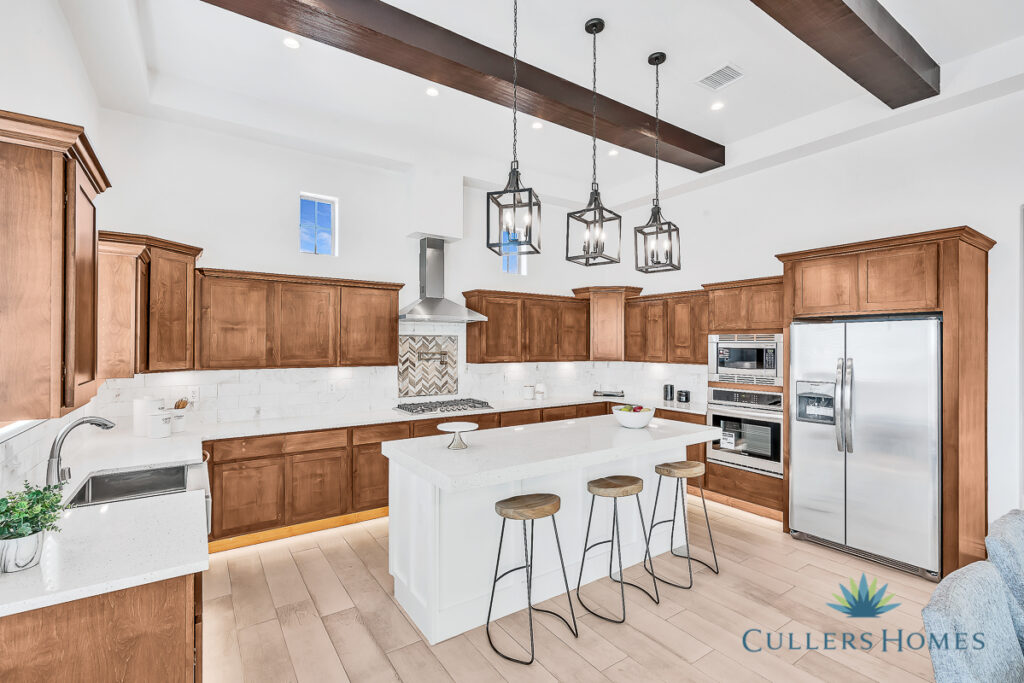Tales from the Kitchen: How Kitchen Appliances Have Changed Over the Decades

Today’s modern kitchen is a sleek, beautiful, multi-functional, high-performing food preparing, snack-making, coffee drinking area infused with natural lighting, contemporary glass light fixtures, counter and storage space, and energy-efficient appliances. A homeowner one hundred years ago could not have conceived of the efficiency and convenience available with today’s kitchen appliances, gadgets, and technology. The transformation did not happen overnight. Decades of engineering, discoveries, development, and economic investment played a role in today’s contemporary kitchen. The function of the kitchen was very different one hundred years ago. The appliances that we use every day have also changed immensely from early on in the 20th century. So how has the refrigerator, stove, and trusty oven toaster changed since then? In this month’s blog, Cullers Homes explores the origin, development, and history of two of your most trusted kitchen appliances.
The Custom Kitchen is Sleek Efficient and Serves Multiple Purposes
When building a custom home, the appliances tend to come last in the design process. When creating the kitchen floor plan, everything is integrated and designed cohesively, meant to maximize space and improve efficiency. Today’s appliances are part of what makes the 21st-century kitchen the powerful and yet convenient cooking zone that it is. The Cullers Homes floor plans will showcase just how powerful and sleek the modern kitchen can be when properly designed. Let’s look at two of the most widely used appliances and how they have changed over the years.
From a Simple Ice Box to a Sophisticated Stainless Steel Efficient Machine
We use it every day, multiple times a day, and we depend on it to keep our food cold, safe, and guarded against critters. Before mechanical refrigeration came into the picture, people depended on ice boxes filled with ice to keep their food cold. Thanks to American businessman Thomas Moore, dairy products could extend their lifespan in the early 1900s. This method was not very efficient, of course—as it melted and had to be emptied regularly. As cities grew, the demand for fresh food also increased. There was a clear need for an appliance that kept food fresh longer.
The classic iceboxes were developed, made out of wood by carpenters but lined with zinc or tin for insulation. In 1913 the first electric refrigerator was made, but it was not until 1927 when General Motors would develop the first widespread commercially used refrigerator. The next refrigerators would move away from vapor compression to using freon. After WWII, the full-scale adoption of modern refrigerators began. In the 70s and 80s, the use of Freon was seen as potentially harmful to the ozone layer and moved fridges away from using chlorofluorocarbons.
The modern fridge often implements:
- Powerful and efficient compressors and evaporation systems that cool the contents inside.
- Use smart technology, digital temperature control, automatic temperature adjustments, vacation mode, and other extraordinary features.
- Some fridges are equipped with touch screens that help you keep tabs on what might be next on your grocery list.
From Simple Burners to a Safe Multi-Functional Stove Top and Oven
In the 1920s, the typical homeowner had a gas cabinet range to heat their food. The appliance was placed on high slender legs, making it easy to operate without bending down. It was revolutionary for its time. It consisted of several gas-fed burners with the hand control in front. The oven was next to it and the broiler oven was below. The temperature was controlled by the heat generator and did not need a flue or a stack. When it comes to design, the 1930s saw the ovens and stoves blending in with the rest of the kitchen, and slowly the appliance became less bulky, more convenient, and more efficient in producing heat. Homeowners today can choose from a gas or electric stove, all of which will have energy-efficient features that make their lives easier.
You can expect to see some of these features in today’s modern ovens and stoves.
- Some ovens include convection elements to ensure an even temperature throughout the appliance.
- Some stoves will include double ovens, which allow people to cook different foods and different temperatures without aromas mixing at all.
- Many ovens implement a self-cleaning function that makes cleaning up the messes easier, more convenient, and faster.
- Newer models have smart technology that allows for control or monitoring from a smartphone or mobile device.
- The stovetop separated from the oven. Modern designers have found that putting the stovetop separately, completely integrated into the cabinets, and placing the ovens separately can avoid the need for bulky appliances.
- As part of the stove element, designers add beautifully crafted range hoods fully integrated with the kitchen design.
For Your Custom Kitchen, See What’s Possible With Cullers Homes
Our custom kitchens are truly revolutionary and an embodiment of contemporary design with a personal touch. We maximize space but never at the expense of beauty or efficiency. Just take a look at some of our amazing designs.
Ready to take your home design to the next level with a custom home builder? Connect with the Cullers Homes team today and find true beauty and functionality.
